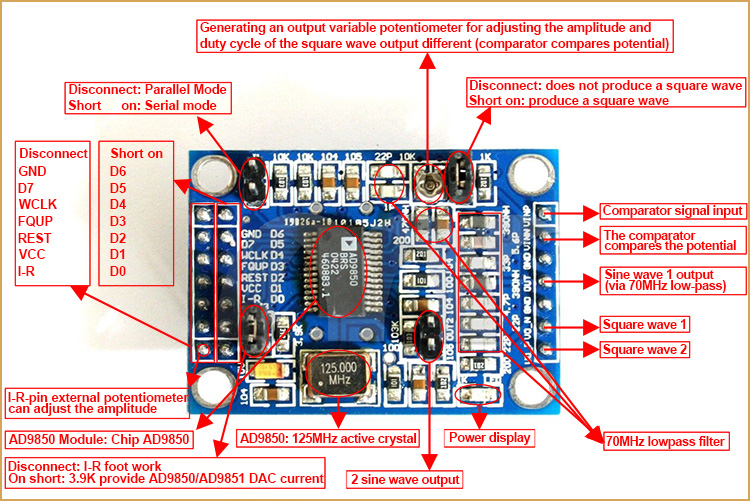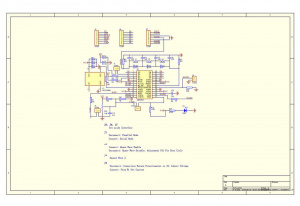Ondeggiatore: Difference between revisions
| (43 intermediate revisions by the same user not shown) | |||
| Line 1: | Line 1: | ||
[[Category:Radio]] | |||
''VFO & controller per ricevitori a conversione diretta (e non)'' | ''VFO & controller per ricevitori a conversione diretta (e non)'' | ||
== | == Codice == | ||
http://nebbia.esiliati.org/repos/cesco/ondeggiatore/ | |||
== | == Interfaccia == | ||
=== Input === | |||
* up + down | |||
* left + right | |||
* enter+exit | |||
=== display === | |||
* ST7032i 16x2, 3.3v, SPI | |||
* ST7032i 16x2, 3.3v, I2C | |||
* SSD1675A 104x212, 3.3v, SPI | |||
http://www.buydisplay.com/default/16x2-lcd-3-3v-character-cog-display-module-black-on-white | |||
{|style="color:blue; background-color:#ffffdd;" cellpadding="10" cellspacing="0" border="1" | |||
!Pin No. | |||
!Pin Name | |||
!Descriptions | |||
|- | |||
|1||XRESET||External reset pin, Only if the power on reset used, The XRESET pin must be fixed to VDD, Active Low. | |||
|- | |||
|2||RS||Select Registers. 0: Instruction Register(for write) Busy Flag & Address Counter(for read) 1: Data Register(for white and read) | |||
|- | |||
|3||CSB||Chip Select Input Pin. Low Active. | |||
|- | |||
|4||SCL||Clock Input Pin | |||
|- | |||
|5||SDA||Input Data Pin | |||
|- | |||
|6||VSS||GND | |||
|- | |||
|7||VDD||Power Supply | |||
|- | |||
|8||VOUT||DC/DC voltage converter. Connect a capacitor between this terminal and VDD when the built-in booster is used. | |||
|- | |||
|9||PSB||SI4(SPI):PSB=0, PSI2B=1; | |||
|- | |||
|10||PSI2B||SI2(IIC):PSB=1,PSI2B=0; | |||
|- | |||
|11||CAP1P||Connect capacitors between CAP1P and CAP1N | |||
|- | |||
|12||CAP1N||Connect capacitors between CAP1P and CAP1N | |||
|} | |||
== Dispositivi supportati == | |||
=== AD9834 === | |||
http://www.analog.com/en/digital-to-analog-converters/direct-digital-synthesis-dds/ad9834/products/product.html | |||
75Mhz, 10bit | |||
Usa i piedini DDS_CS, SCK, SDO | |||
=== AD9850 === | |||
http://www.analog.com/en/products/rf-microwave/direct-digital-synthesis/ad9850.html | |||
SSOP28, 3.3-5 V, 125Mhz, 10bit, SFDR > 50 dB @ 40 MHz | |||
Usa i piedini DDS_CS, SCK, SDO sul uC | |||
In commercio si trovano gia assemblati due moduli: | |||
== | ==== Modulo con Rset esposta ==== | ||
[[File:AD9850-Module.jpg|foto]] | |||
[[File:9850 DDS rset.jpg|thumb|none]] | |||
==== Modulo HC-SR08 ==== | |||
[[:File:HC-SR08 AD9850 Module.png|schema]] | |||
Piedinatura: | |||
{|style="color: | {|style="color:blue; background-color:#ffffdd;" cellpadding="10" cellspacing="0" border="1" | ||
!Pin | !Pin | ||
!Funzione | !Funzione | ||
|- | |- | ||
| | |1||VCC | ||
|- | |- | ||
| | |2||W_CLK | ||
|- | |- | ||
| | |3||FU_UD | ||
|- | |- | ||
| | |4||SDI | ||
|- | |- | ||
| | |5||Reset | ||
|- | |- | ||
| | |6||GND | ||
|- | |- | ||
| | |7||Square Out 1 | ||
|- | |- | ||
| | |8||Square Out 2 | ||
|- | |- | ||
| | |9||Sine Out 1 | ||
|- | |- | ||
| | |10||Sine Out 2 | ||
|- | |- | ||
| | |11||GND | ||
|- | |- | ||
| | |12||D7 | ||
|- | |- | ||
| | |13||D6 | ||
|- | |- | ||
| | |14||D5 | ||
|- | |- | ||
| | |15||D4 | ||
|- | |- | ||
| | |16||D3 | ||
|- | |- | ||
| | |17||D2 | ||
|- | |- | ||
| | |18||D1 | ||
|- | |- | ||
| | |19||D0 | ||
|- | |- | ||
| | |20||VCC | ||
|- | |- | ||
|} | |} | ||
== | === SI570 === | ||
Si570 CAC000141DG http://www.silabs.com/Support%20Documents/TechnicalDocs/si570.pdf | |||
Fout = (fXTAL * RFREQ)/(HSDIV * N1) | |||
* http://g4oep.atspace.com/si570vfo/570VFO.htm | |||
* http://www.cliftonlaboratories.com/si570_kit_from_k5bcq.htm | |||
=== Si5351a === | |||
https://www.silabs.com/Support%20Documents/TechnicalDocs/Si5351-B.pdf | |||
0.0025 — 200 MHz | |||
* https://www.qrp-labs.com/synth/si5351ademo.html | |||
== Filtro == | |||
l'uscita dei DDS va fatta passare per un 'filtro di ricostruzione', che tagli via per quanto possibile le spurie e le armoniche di campionamento del DAC | |||
si puo copiare da questo: http://www.pongrance.com/super-dds.html che pero ha un clock di 80mhz (cambia poco) | |||
o questo http://www.elecraft.com/manual/KX1_Owner%27s_Manual_Rev_E.pdf, che e' tagliato un po piu basso | |||
http://www.analog.com/static/imported-files/application_notes/351016224AN_837.pdf | |||
* ad9951 http://www.m0rjd.co.uk/LO.html | |||
== uC == | |||
* PIC24F16KM202 http://www.microchip.com/wwwproducts/Devices.aspx?dDocName=en560805 | |||
* riceve l'input dai tasti (6 pin) o dall'encoder (4 + 2) | |||
* riceve l'input da eventuale PTT (shift) (1 pin) | |||
* riceve l'input da eventuale Carrier Detect (per lo scan) (1 pin) | |||
* controlla il LCD (SPI) | |||
* controlla il DDS (SPI) / Oscillatore (I2C) | |||
* controlla la Rset del DDS (1 pin) | |||
* controlla il banco filtri (4 pin) | |||
* controlla la backlight (1 pin) | |||
* si interfaccia con la memoria EEPROM (SPI) | |||
24 pin totali di I/O | |||
* | * DDS, lcd e memoria esterna possono convivere sul modulo SPI | ||
=== Mappa pin === | |||
Usa il layout di [[CodecBoard16]] | |||
== memoria esterna == | == memoria esterna == | ||
| Line 194: | Line 245: | ||
* frequency register su eeprom interna | * frequency register su eeprom interna | ||
* DDS clock | * DDS clock | ||
la memoria viene divisa in blocchi da 32byte | la memoria viene divisa in blocchi da 32byte | ||
| Line 238: | Line 287: | ||
|band_name||band_step||frequency_min||frequency_max||flag | |band_name||band_step||frequency_min||frequency_max||flag | ||
|} | |} | ||
Latest revision as of 21:13, 2 April 2018
VFO & controller per ricevitori a conversione diretta (e non)
Codice
http://nebbia.esiliati.org/repos/cesco/ondeggiatore/
Interfaccia
Input
- up + down
- left + right
- enter+exit
display
- ST7032i 16x2, 3.3v, SPI
- ST7032i 16x2, 3.3v, I2C
- SSD1675A 104x212, 3.3v, SPI
http://www.buydisplay.com/default/16x2-lcd-3-3v-character-cog-display-module-black-on-white
| Pin No. | Pin Name | Descriptions |
|---|---|---|
| 1 | XRESET | External reset pin, Only if the power on reset used, The XRESET pin must be fixed to VDD, Active Low. |
| 2 | RS | Select Registers. 0: Instruction Register(for write) Busy Flag & Address Counter(for read) 1: Data Register(for white and read) |
| 3 | CSB | Chip Select Input Pin. Low Active. |
| 4 | SCL | Clock Input Pin |
| 5 | SDA | Input Data Pin |
| 6 | VSS | GND |
| 7 | VDD | Power Supply |
| 8 | VOUT | DC/DC voltage converter. Connect a capacitor between this terminal and VDD when the built-in booster is used. |
| 9 | PSB | SI4(SPI):PSB=0, PSI2B=1; |
| 10 | PSI2B | SI2(IIC):PSB=1,PSI2B=0; |
| 11 | CAP1P | Connect capacitors between CAP1P and CAP1N |
| 12 | CAP1N | Connect capacitors between CAP1P and CAP1N |
Dispositivi supportati
AD9834
75Mhz, 10bit
Usa i piedini DDS_CS, SCK, SDO
AD9850
http://www.analog.com/en/products/rf-microwave/direct-digital-synthesis/ad9850.html
SSOP28, 3.3-5 V, 125Mhz, 10bit, SFDR > 50 dB @ 40 MHz
Usa i piedini DDS_CS, SCK, SDO sul uC
In commercio si trovano gia assemblati due moduli:
Modulo con Rset esposta
Modulo HC-SR08
Piedinatura:
| Pin | Funzione |
|---|---|
| 1 | VCC |
| 2 | W_CLK |
| 3 | FU_UD |
| 4 | SDI |
| 5 | Reset |
| 6 | GND |
| 7 | Square Out 1 |
| 8 | Square Out 2 |
| 9 | Sine Out 1 |
| 10 | Sine Out 2 |
| 11 | GND |
| 12 | D7 |
| 13 | D6 |
| 14 | D5 |
| 15 | D4 |
| 16 | D3 |
| 17 | D2 |
| 18 | D1 |
| 19 | D0 |
| 20 | VCC |
SI570
Si570 CAC000141DG http://www.silabs.com/Support%20Documents/TechnicalDocs/si570.pdf
Fout = (fXTAL * RFREQ)/(HSDIV * N1)
- http://g4oep.atspace.com/si570vfo/570VFO.htm
- http://www.cliftonlaboratories.com/si570_kit_from_k5bcq.htm
Si5351a
https://www.silabs.com/Support%20Documents/TechnicalDocs/Si5351-B.pdf
0.0025 — 200 MHz
Filtro
l'uscita dei DDS va fatta passare per un 'filtro di ricostruzione', che tagli via per quanto possibile le spurie e le armoniche di campionamento del DAC
si puo copiare da questo: http://www.pongrance.com/super-dds.html che pero ha un clock di 80mhz (cambia poco)
o questo http://www.elecraft.com/manual/KX1_Owner%27s_Manual_Rev_E.pdf, che e' tagliato un po piu basso
http://www.analog.com/static/imported-files/application_notes/351016224AN_837.pdf
uC
- riceve l'input dai tasti (6 pin) o dall'encoder (4 + 2)
- riceve l'input da eventuale PTT (shift) (1 pin)
- riceve l'input da eventuale Carrier Detect (per lo scan) (1 pin)
- controlla il LCD (SPI)
- controlla il DDS (SPI) / Oscillatore (I2C)
- controlla la Rset del DDS (1 pin)
- controlla il banco filtri (4 pin)
- controlla la backlight (1 pin)
- si interfaccia con la memoria EEPROM (SPI)
24 pin totali di I/O
- DDS, lcd e memoria esterna possono convivere sul modulo SPI
Mappa pin
Usa il layout di CodecBoard16
memoria esterna
- EEPROM 256 kbit 25LC256 o 25LC512
Connettori
Controllo
| Pin | Funzione | Nome |
|---|---|---|
| 1 | FILTER_1 | |
| 2 | FILTER_2 | |
| 3 | FILTER_3 | |
| 4 | FILTER_4 | |
| 5 | CD | |
| 6 | PTT |
UART
| Pin | Funzione | Nome |
|---|---|---|
| 1 | Massa | GND |
| 2 | Uart tx | TX |
| 3 | Uart rx | RX |
Firmware
Features
- canali con nome alfanumerico su memoria esterna
- bande con nome alfanumerico su memoria esterna
- step (1,10,100,500,1000,1250,2500,5000,9000,10000,50000,100000,1000000) (4 byte) o semplicemente potenze di 10 ? su eeprom interna
- frequenza 0 - 30 MHz su eeprom interna (4 byte)
- shift TX/RX (+- 0 - 30 MHz) su eeprom interna (4 byte)
- IF (+- 0 - 30 MHz) su eeprom interna (4 byte)
- additiva: il display mostra la frequenza dell'IF + la frequenza del VFO
- sottrattiva: il display mostra la frequenza dell'IF - la frequenza del VFO
- scan (volatile)
- dentro banda
- dei canali
- filtri su eeprom interna
- numero (1 byte)
- fmin (4 byte)
- fmax (4 byte)
- phase register su eeprom interna
- frequency register su eeprom interna
- DDS clock
la memoria viene divisa in blocchi da 32byte
ogni nuovo canale/banda viene memorizzato nel primo blocco/canale flaggato come non attivo
quando si naviga tra i canali/bande, vengono letti i blocchi in ordine finche non si trova il successivo canale/banda
Flag
| 00 | non attivo |
| 01 | canale |
| 10 | gruppo |
| 11 | banda |
Canale
| 16-31 | 12-15 | 1 | 0 |
| channel_name | frequency | group_id | flag |
Gruppo
| 16-31 | 1 | 0 |
| group_name | group_id | flag |
Banda
| 16-31 | 12-15 | 8-11 | 4-7 | 0 |
| band_name | band_step | frequency_min | frequency_max | flag |

